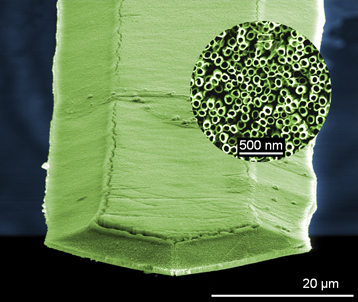By Kalwinder KaurJun 2 2012
A research team from the “Nanomatériaux pour Systèmes sous Sollicitations Extrêmes” unit (CNRS / Institut Franco-Allemand de Recherches de Saint-Louis) has devised a system that can effectively detect explosives. This latest development, which was accomplished through collaboration with the Laboratoire des Matériaux, Surfaces et Procédés pour la Catalyse (CNRS / Université de Strasbourg), was inspired from the silkmoth, Bombyx mori.
 © Fabien Schnell/NS3E Overall view of a microcantilever nanostructured by aligned titanium dioxide nanotubes.
© Fabien Schnell/NS3E Overall view of a microcantilever nanostructured by aligned titanium dioxide nanotubes.
It is difficult to detect trinitrotoluene (TNT) concentrations as these compounds exhibit low volatility levels and require sensitive sensors to detect them. In fact, existing systems can detect about 1 ppb (2) concentrations. However, this degree of detection is not sufficient. On the other hand, animals are known for possessing a good sense of smell. The silkmoth for instance can respond to the capture of just a small number of pheromone molecules. The antennas of this insect contain a number of sensilla, and researchers are attempting to imitate this very same structure.
The new system features a silicon microcantilever that measures 200-µ long and 30-µ wide and contains 500,000 vertically joined titanium dioxide nanotubes. These nanotubes increase the microcantilever’s surface area to about 100 and raise the possibilities of capturing the molecules that is being searched. Through the vibration of the microcantilever, traces of TNT in the ambient air as well as the arrest of these molecules by the device can be determined.
The bio-inspired device can detect TNT concentrations of approximately 800 ppq (1), which is 1000x the detection limit achieved so far, and this efficiency levels are comparable to that of sniffer dogs. The device can also be employed to detect toxic agents, drugs and organic pollutants. Present generation of devices are not capable of detecting such low concentrations of explosives.
However, more research is needed before an appropriate device can be developed. The research work has appeared in the journal, Angewandte Chemie.
Source: http://www.cnrs.fr/
Disclaimer: The views expressed here are those of the author expressed in their private capacity and do not necessarily represent the views of AZoM.com Limited T/A AZoNetwork the owner and operator of this website. This disclaimer forms part of the Terms and conditions of use of this website.